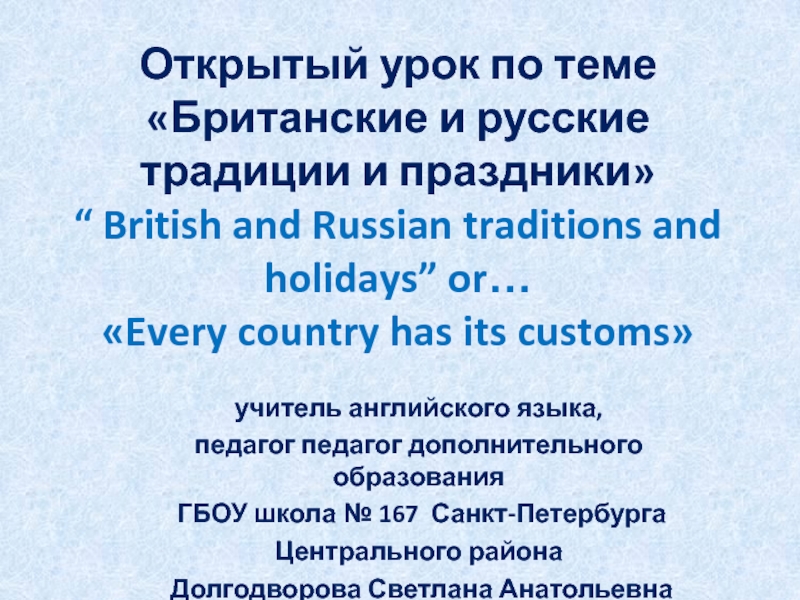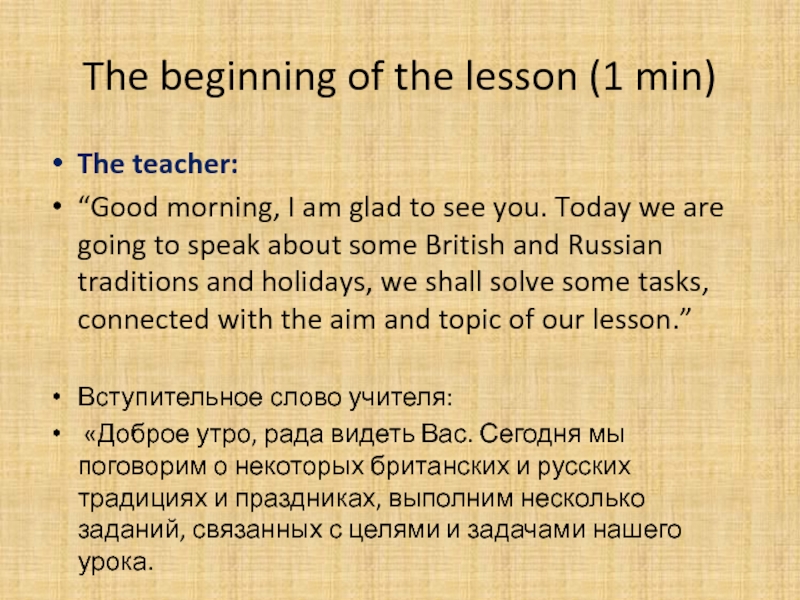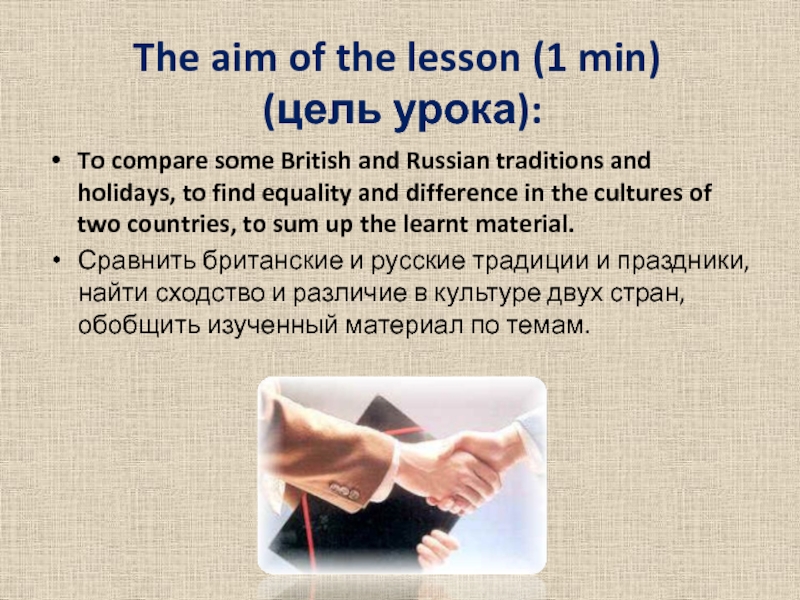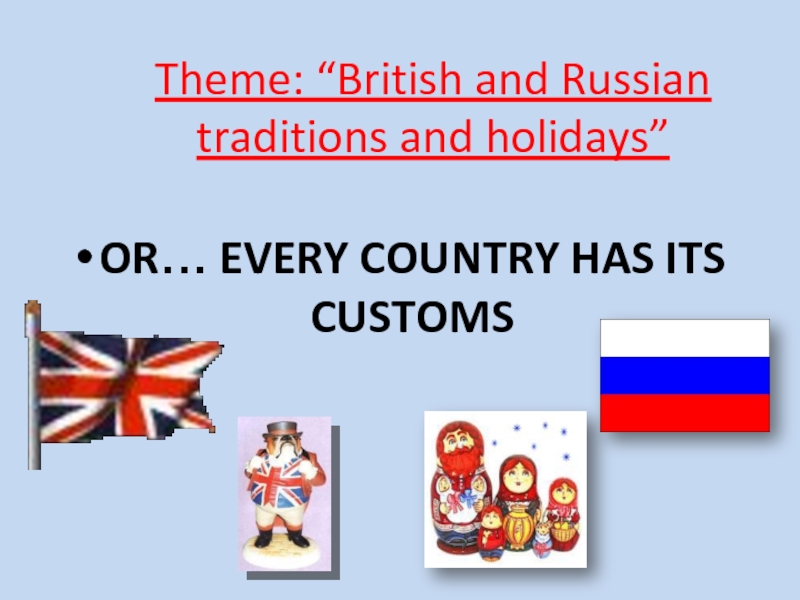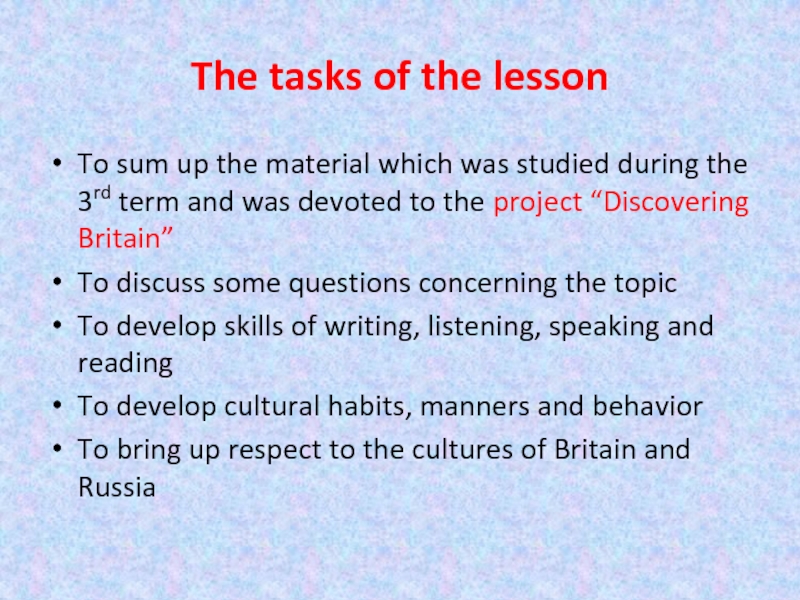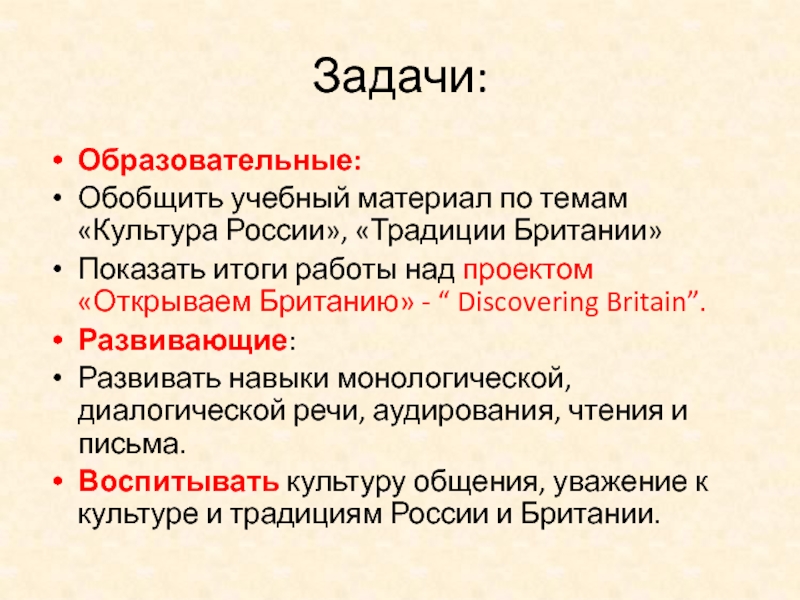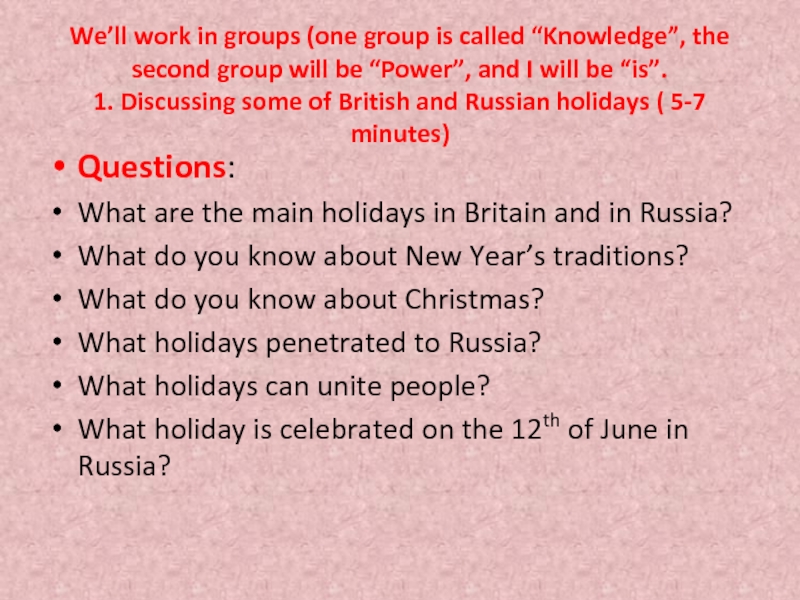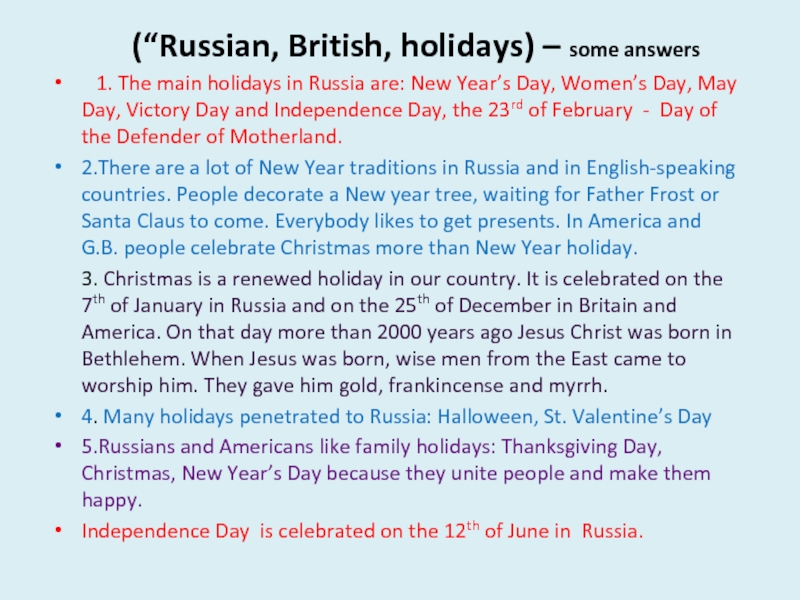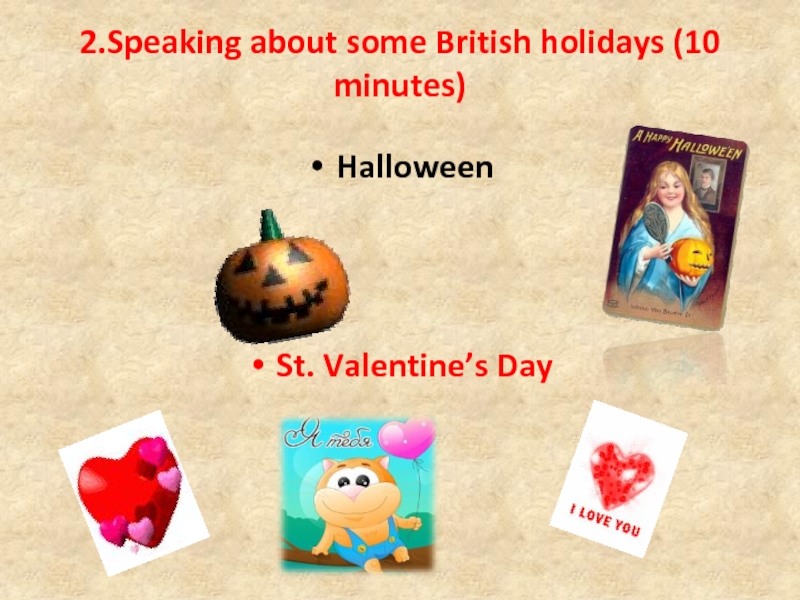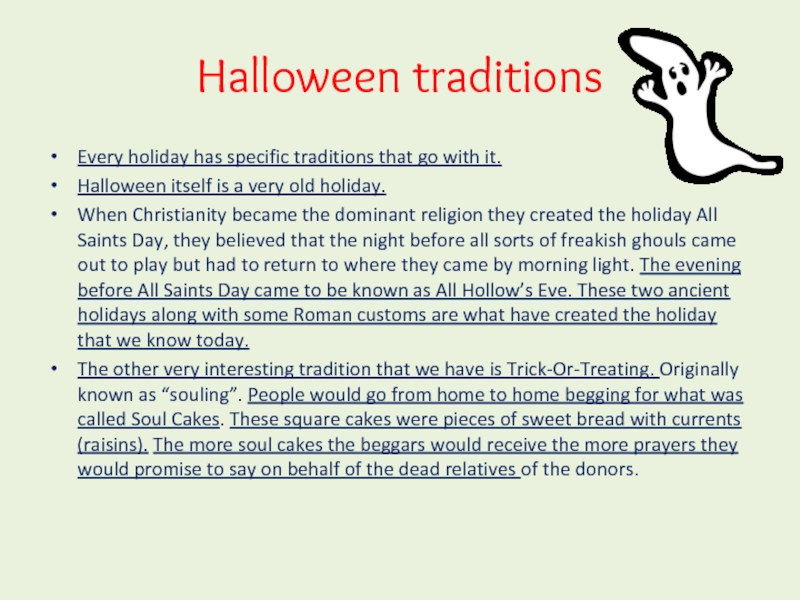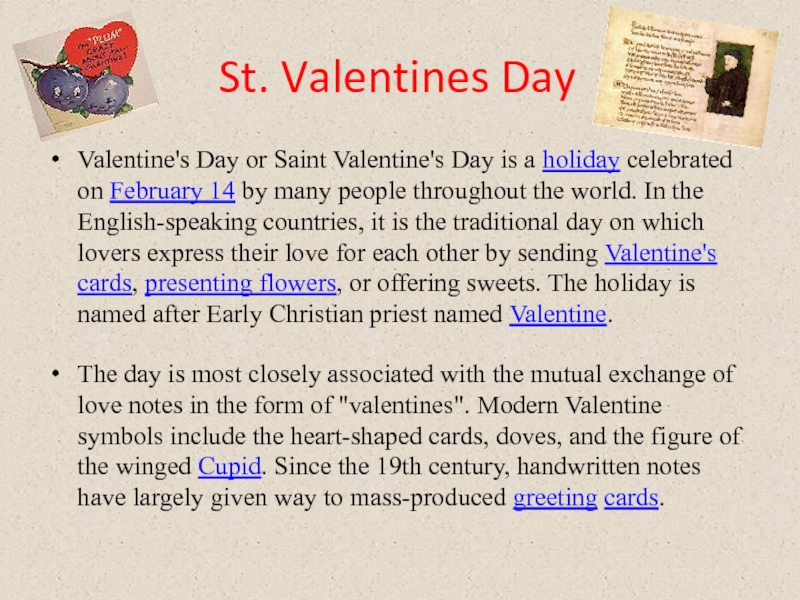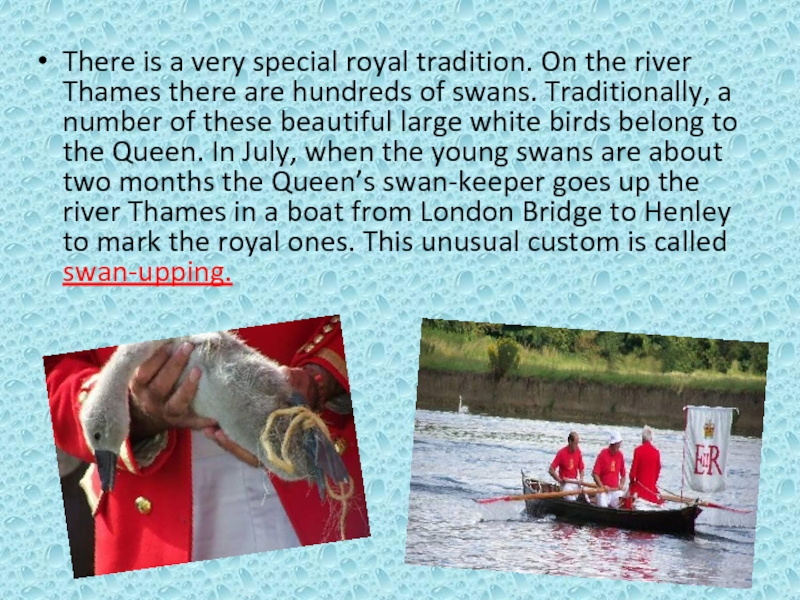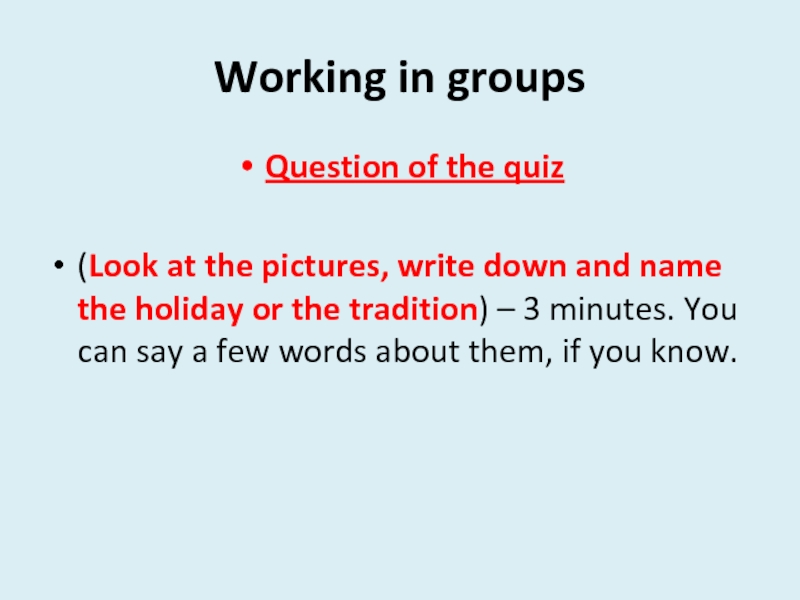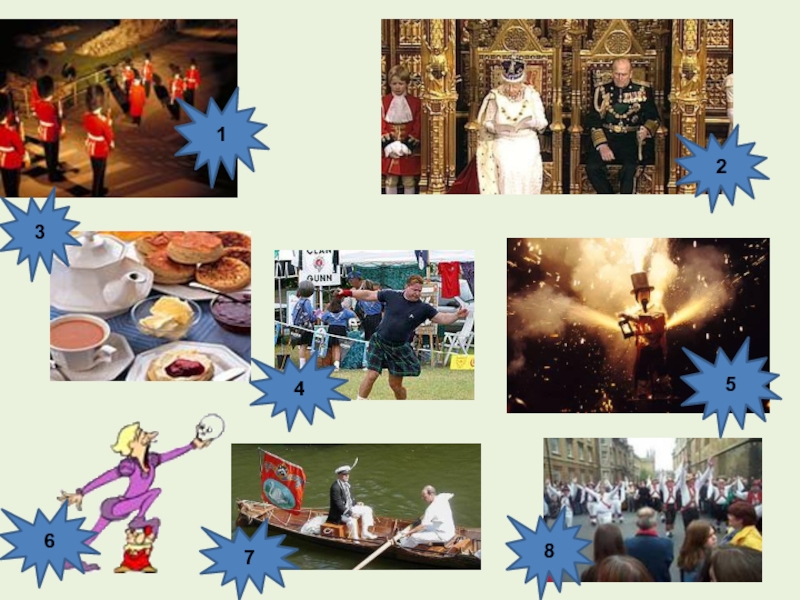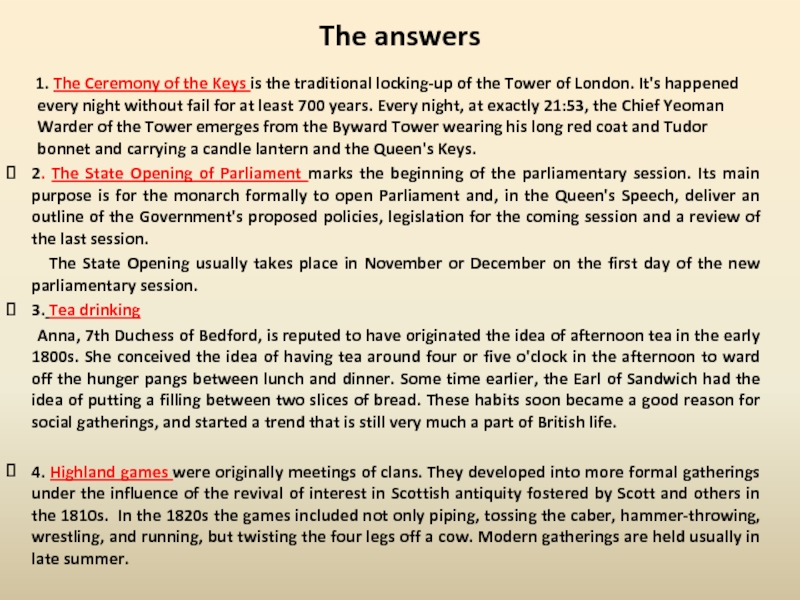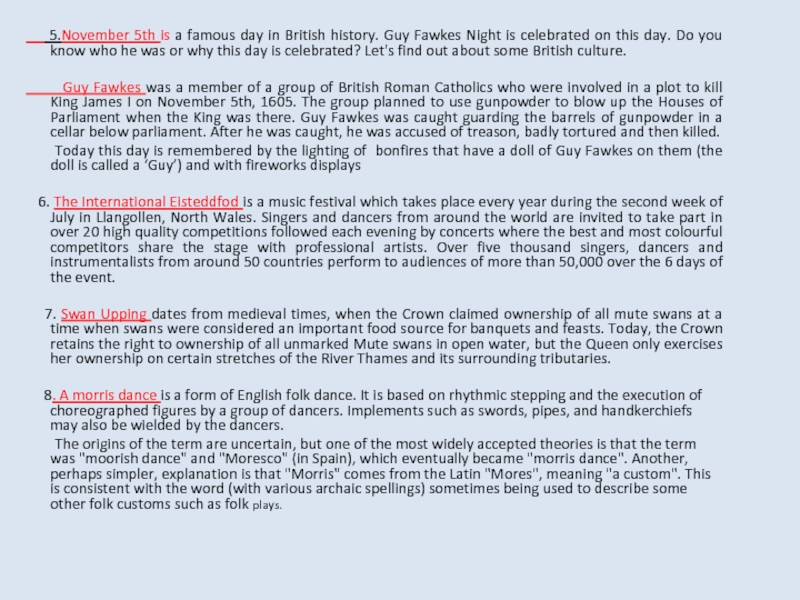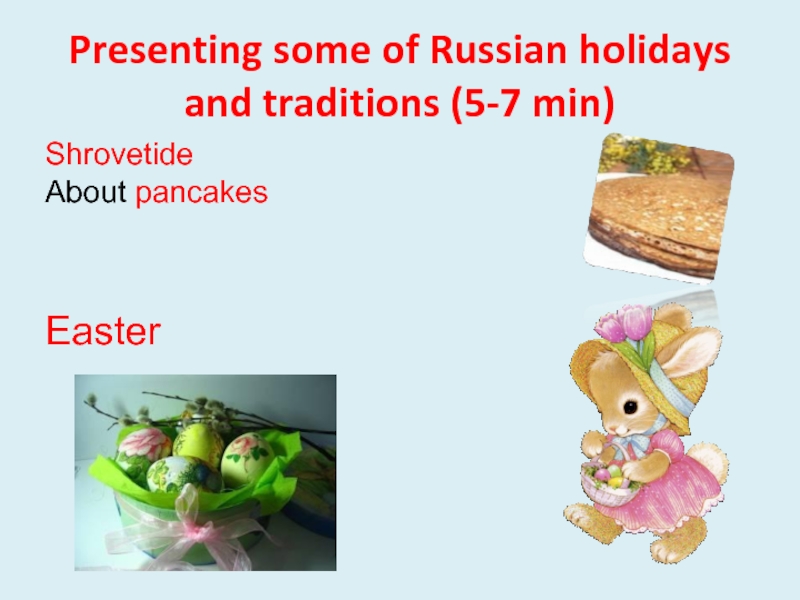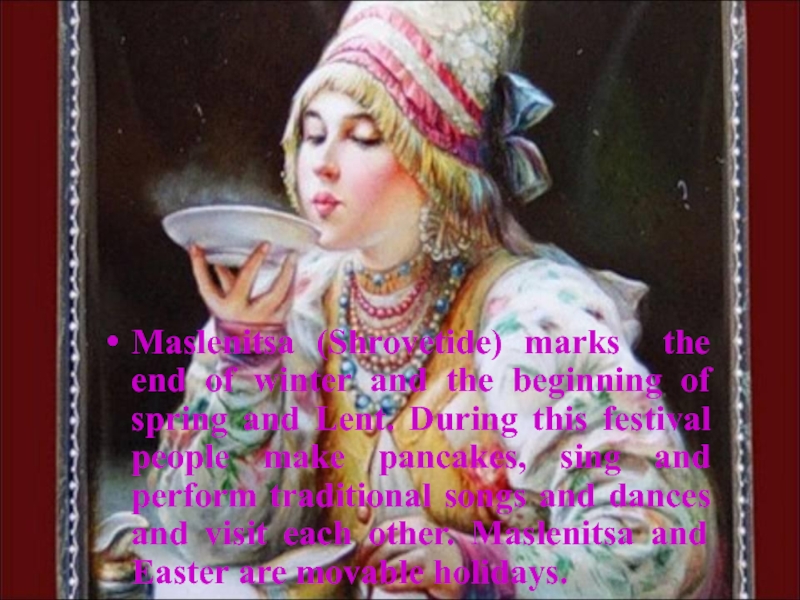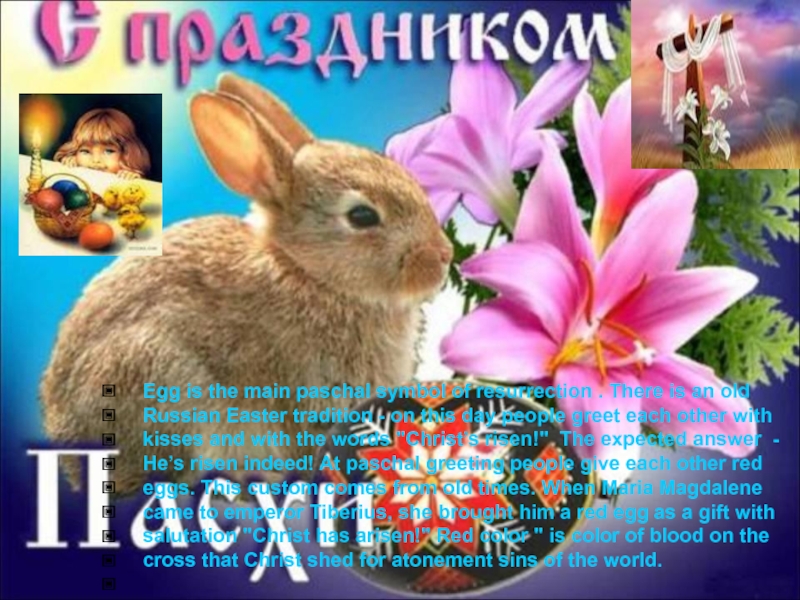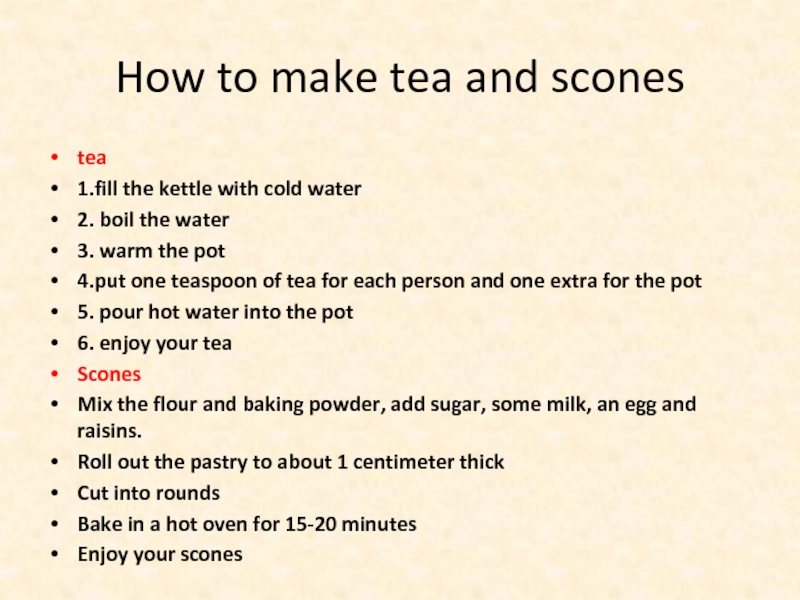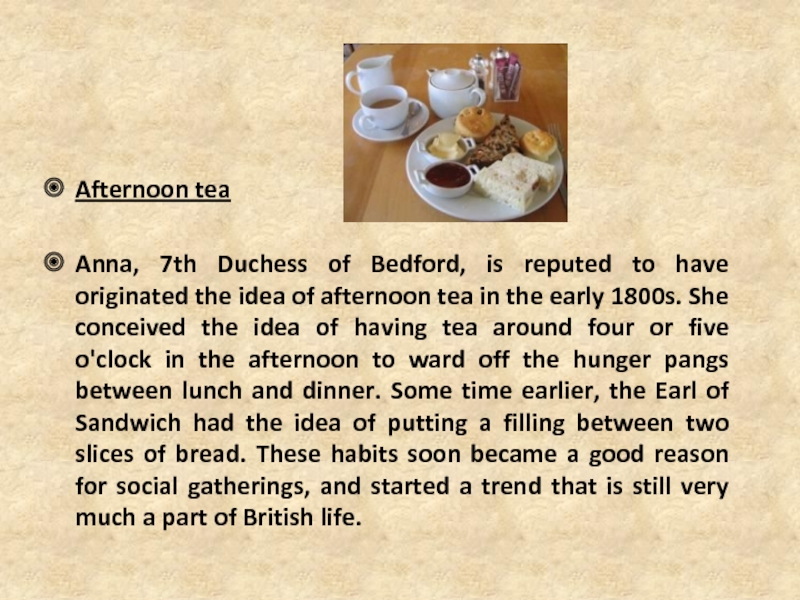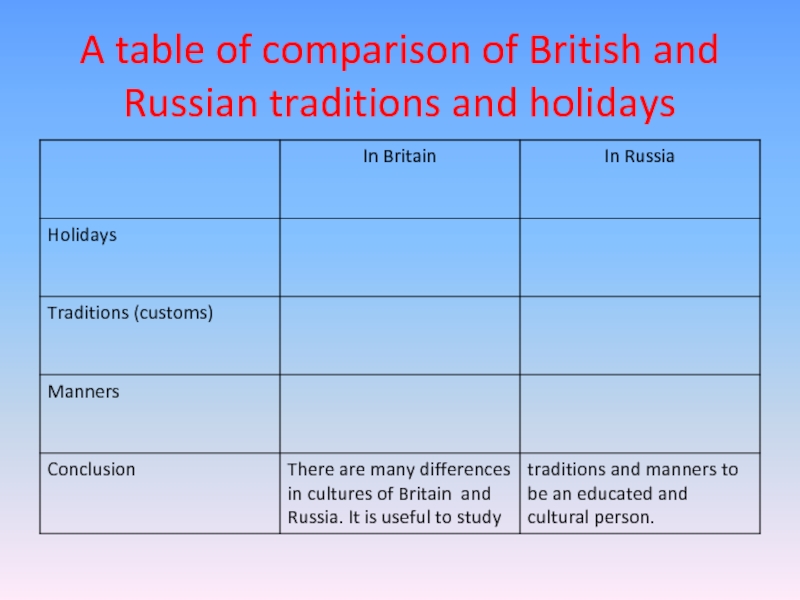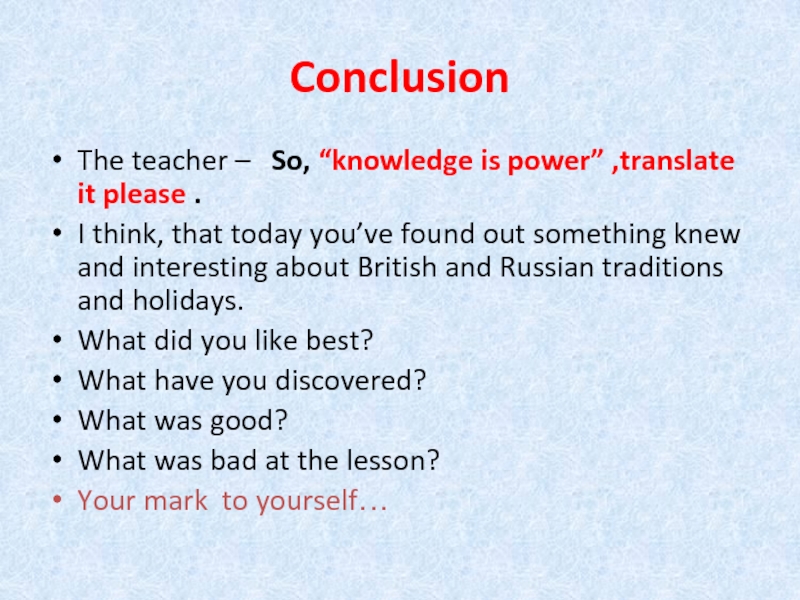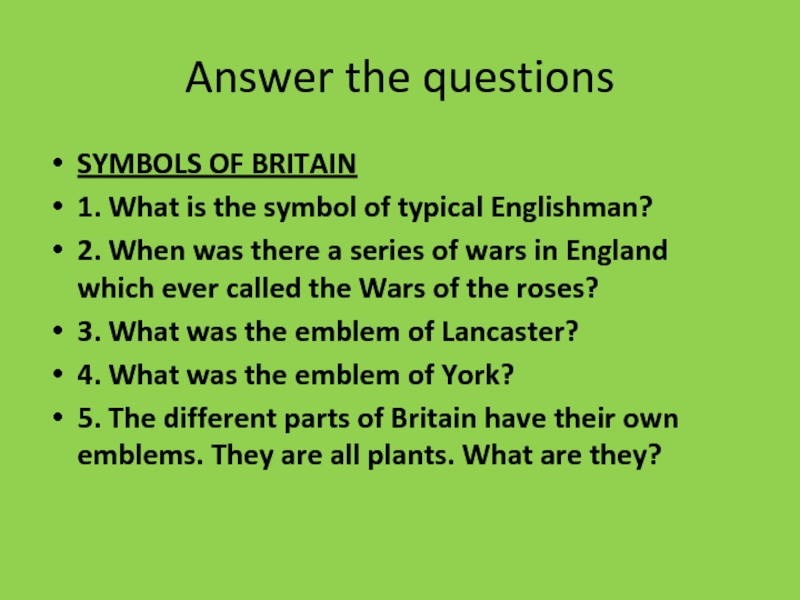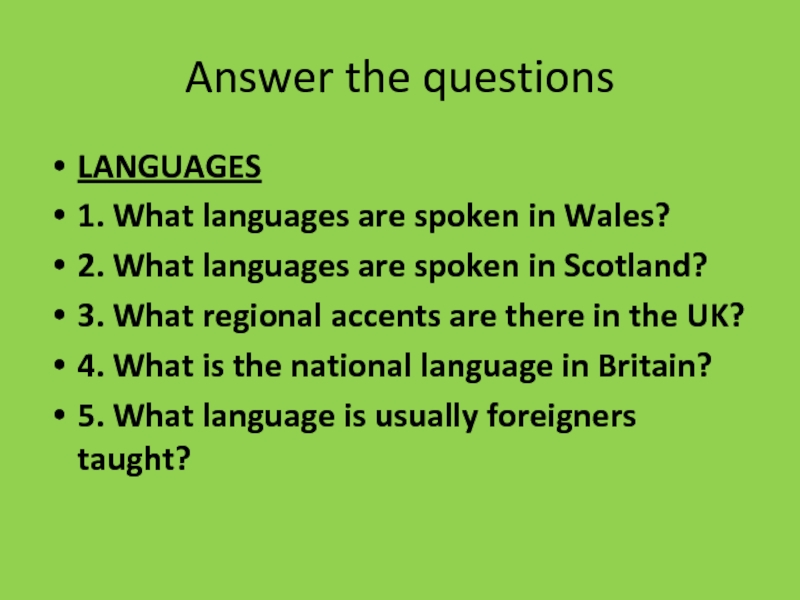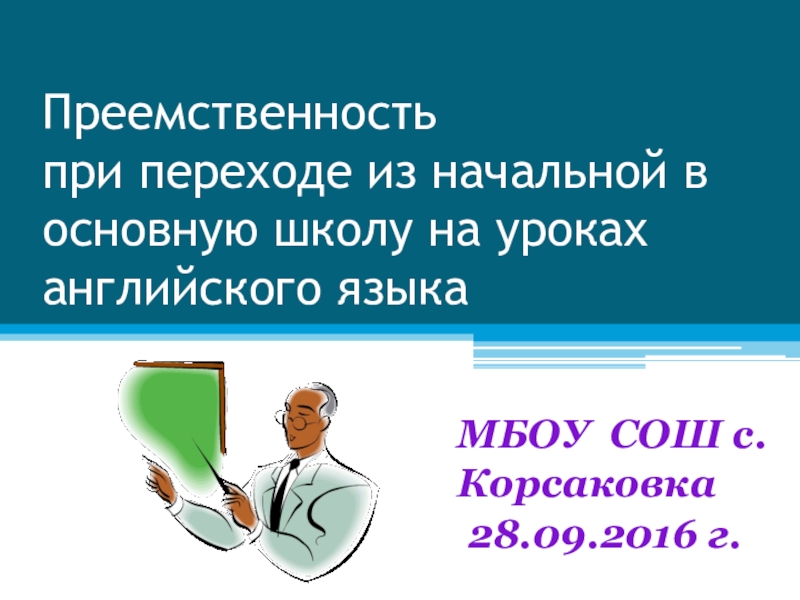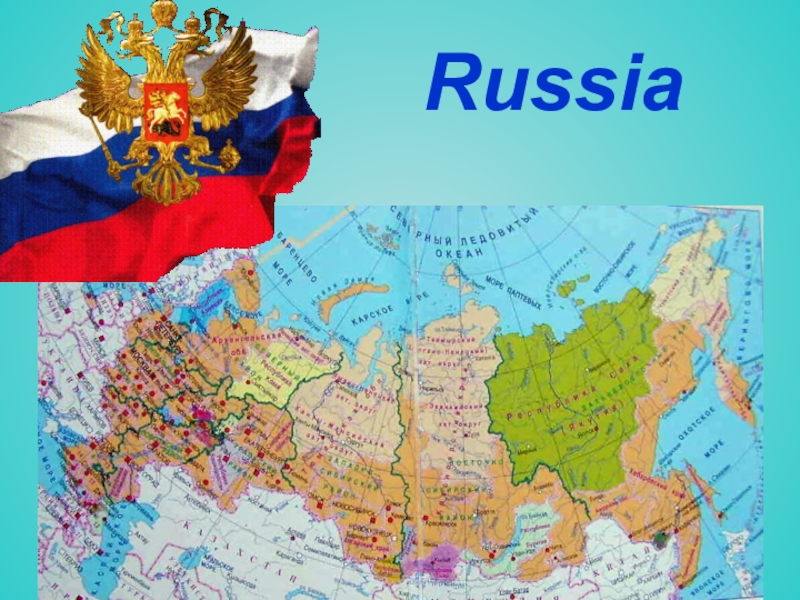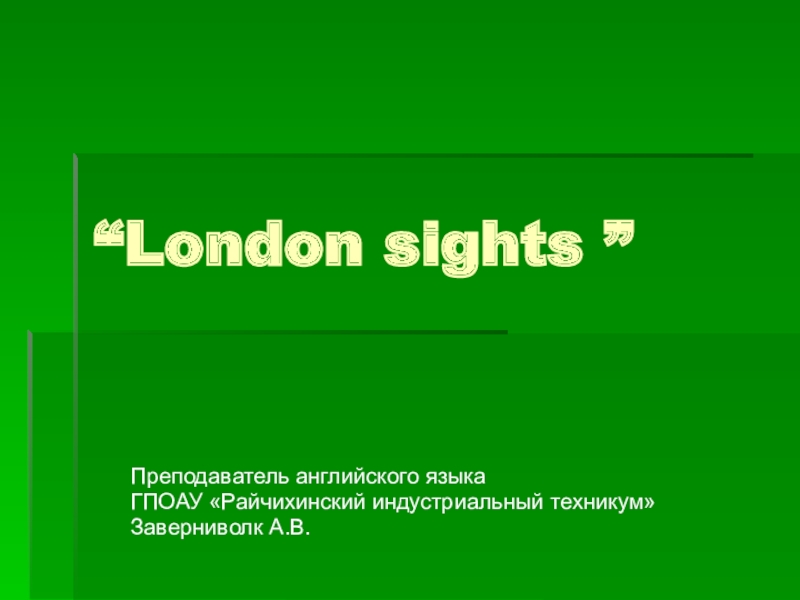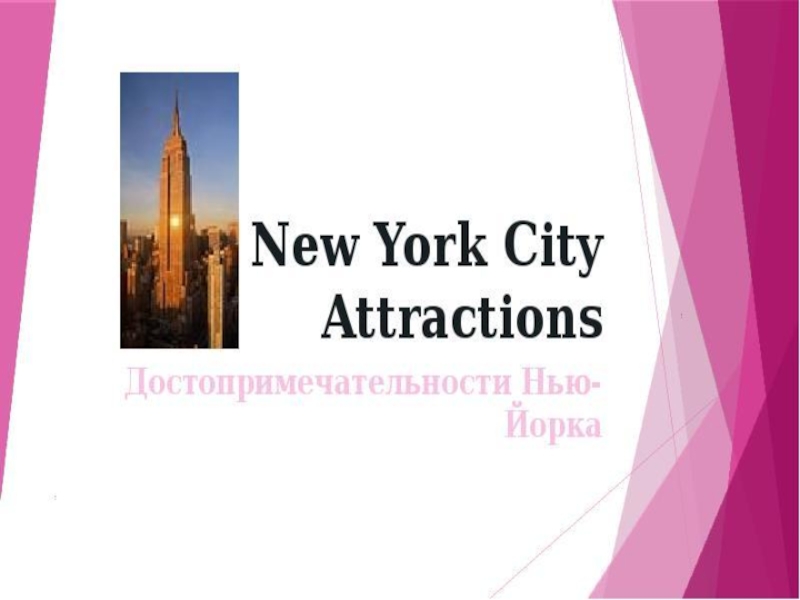учитель английского языка,
педагог педагог дополнительного образования
ГБОУ школа № 167 Санкт-Петербурга
Центрального района
Долгодворова Светлана Анатольевна
- Главная
- Разное
- Образование
- Спорт
- Естествознание
- Природоведение
- Религиоведение
- Французский язык
- Черчение
- Английский язык
- Астрономия
- Алгебра
- Биология
- География
- Геометрия
- Детские презентации
- Информатика
- История
- Литература
- Математика
- Музыка
- МХК
- Немецкий язык
- ОБЖ
- Обществознание
- Окружающий мир
- Педагогика
- Русский язык
- Технология
- Физика
- Философия
- Химия
- Шаблоны, фоны, картинки для презентаций
- Экология
- Экономика
Презентация, доклад по английскому языку Британские традиции(9 класс)
Содержание
- 1. Презентация по английскому языку Британские традиции(9 класс)
- 2. The beginning of the lesson (1 min)The
- 3. The aim of the lesson (1 min)
- 4. Theme: “British and Russian traditions and holidays”OR… EVERY COUNTRY HAS ITS CUSTOMS
- 5. The tasks of the lessonTo sum up
- 6. Задачи:Образовательные:Обобщить учебный материал по темам «Культура России»,
- 7. We’ll work in groups (one group is
- 8. (“Russian, British,
- 9. 2.Speaking about some British holidays (10 minutes) Halloween St. Valentine’s Day
- 10. Halloween traditionsEvery holiday has specific traditions that
- 11. St. Valentines DayValentine's Day or Saint Valentine's
- 12. There is a very special royal tradition.
- 13. Working in groupsQuestion of the quiz(Look at
- 14. 12345678
- 15. The answers 1.
- 16. 5.November 5th is a
- 17. Presenting some of Russian holidays and traditions (5-7 min)ShrovetideAbout pancakesEaster
- 18. Maslenitsa (Shrovetide) marks the end of winter
- 19. Pancakes recipe: take some flour, an
- 20. Egg is the main paschal symbol of
- 21. How to make tea and sconestea1.fill the
- 22. Afternoon teaAnna, 7th Duchess of Bedford, is
- 23. A table of comparison of British and Russian traditions and holidays
- 24. ConclusionThe teacher – So, “knowledge is
- 25. Answer the questionsSYMBOLS OF BRITAIN1. What is
- 26. Answer the questionsLANGUAGES1. What languages are spoken
The beginning of the lesson (1 min)The teacher: “Good morning, I am glad to see you. Today we are going to speak about some British and Russian traditions and holidays, we shall solve some tasks, connected
Слайд 1 Открытый урок по теме «Британские и русские традиции и праздники» “
British and Russian traditions and holidays” or…
«Every country has its customs»
Слайд 2The beginning of the lesson (1 min)
The teacher:
“Good morning, I
am glad to see you. Today we are going to speak about some British and Russian traditions and holidays, we shall solve some tasks, connected with the aim and topic of our lesson.”
Вступительное слово учителя:
«Доброе утро, рада видеть Вас. Сегодня мы поговорим о некоторых британских и русских традициях и праздниках, выполним несколько заданий, связанных с целями и задачами нашего урока.
Вступительное слово учителя:
«Доброе утро, рада видеть Вас. Сегодня мы поговорим о некоторых британских и русских традициях и праздниках, выполним несколько заданий, связанных с целями и задачами нашего урока.
Слайд 3The aim of the lesson (1 min)
(цель урока):
To compare some
British and Russian traditions and holidays, to find equality and difference in the cultures of two countries, to sum up the learnt material.
Сравнить британские и русские традиции и праздники, найти сходство и различие в культуре двух стран, обобщить изученный материал по темам.
Сравнить британские и русские традиции и праздники, найти сходство и различие в культуре двух стран, обобщить изученный материал по темам.
Слайд 5The tasks of the lesson
To sum up the material which was
studied during the 3rd term and was devoted to the project “Discovering Britain”
To discuss some questions concerning the topic
To develop skills of writing, listening, speaking and reading
To develop cultural habits, manners and behavior
To bring up respect to the cultures of Britain and Russia
To discuss some questions concerning the topic
To develop skills of writing, listening, speaking and reading
To develop cultural habits, manners and behavior
To bring up respect to the cultures of Britain and Russia
Слайд 6Задачи:
Образовательные:
Обобщить учебный материал по темам «Культура России», «Традиции Британии»
Показать итоги работы
над проектом «Открываем Британию» - “ Discovering Britain”.
Развивающие:
Развивать навыки монологической, диалогической речи, аудирования, чтения и письма.
Воспитывать культуру общения, уважение к культуре и традициям России и Британии.
Развивающие:
Развивать навыки монологической, диалогической речи, аудирования, чтения и письма.
Воспитывать культуру общения, уважение к культуре и традициям России и Британии.
Слайд 7We’ll work in groups (one group is called “Knowledge”, the second
group will be “Power”, and I will be “is”.
1. Discussing some of British and Russian holidays ( 5-7 minutes)
Questions:
What are the main holidays in Britain and in Russia?
What do you know about New Year’s traditions?
What do you know about Christmas?
What holidays penetrated to Russia?
What holidays can unite people?
What holiday is celebrated on the 12th of June in Russia?
Слайд 8 (“Russian, British, holidays) – some answers
1. The main holidays in Russia are: New Year’s Day, Women’s Day, May Day, Victory Day and Independence Day, the 23rd of February - Day of the Defender of Motherland.
2.There are a lot of New Year traditions in Russia and in English-speaking countries. People decorate a New year tree, waiting for Father Frost or Santa Claus to come. Everybody likes to get presents. In America and G.B. people celebrate Christmas more than New Year holiday.
3. Christmas is a renewed holiday in our country. It is celebrated on the 7th of January in Russia and on the 25th of December in Britain and America. On that day more than 2000 years ago Jesus Christ was born in Bethlehem. When Jesus was born, wise men from the East came to worship him. They gave him gold, frankincense and myrrh.
4. Many holidays penetrated to Russia: Halloween, St. Valentine’s Day
5.Russians and Americans like family holidays: Thanksgiving Day, Christmas, New Year’s Day because they unite people and make them happy.
Independence Day is celebrated on the 12th of June in Russia.
2.There are a lot of New Year traditions in Russia and in English-speaking countries. People decorate a New year tree, waiting for Father Frost or Santa Claus to come. Everybody likes to get presents. In America and G.B. people celebrate Christmas more than New Year holiday.
3. Christmas is a renewed holiday in our country. It is celebrated on the 7th of January in Russia and on the 25th of December in Britain and America. On that day more than 2000 years ago Jesus Christ was born in Bethlehem. When Jesus was born, wise men from the East came to worship him. They gave him gold, frankincense and myrrh.
4. Many holidays penetrated to Russia: Halloween, St. Valentine’s Day
5.Russians and Americans like family holidays: Thanksgiving Day, Christmas, New Year’s Day because they unite people and make them happy.
Independence Day is celebrated on the 12th of June in Russia.
Слайд 10Halloween traditions
Every holiday has specific traditions that go with it.
Halloween itself
is a very old holiday.
When Christianity became the dominant religion they created the holiday All Saints Day, they believed that the night before all sorts of freakish ghouls came out to play but had to return to where they came by morning light. The evening before All Saints Day came to be known as All Hollow’s Eve. These two ancient holidays along with some Roman customs are what have created the holiday that we know today.
The other very interesting tradition that we have is Trick-Or-Treating. Originally known as “souling”. People would go from home to home begging for what was called Soul Cakes. These square cakes were pieces of sweet bread with currents (raisins). The more soul cakes the beggars would receive the more prayers they would promise to say on behalf of the dead relatives of the donors.
When Christianity became the dominant religion they created the holiday All Saints Day, they believed that the night before all sorts of freakish ghouls came out to play but had to return to where they came by morning light. The evening before All Saints Day came to be known as All Hollow’s Eve. These two ancient holidays along with some Roman customs are what have created the holiday that we know today.
The other very interesting tradition that we have is Trick-Or-Treating. Originally known as “souling”. People would go from home to home begging for what was called Soul Cakes. These square cakes were pieces of sweet bread with currents (raisins). The more soul cakes the beggars would receive the more prayers they would promise to say on behalf of the dead relatives of the donors.
Слайд 11St. Valentines Day
Valentine's Day or Saint Valentine's Day is a holiday
celebrated on February 14 by many people throughout the world. In the English-speaking countries, it is the traditional day on which lovers express their love for each other by sending Valentine's cards, presenting flowers, or offering sweets. The holiday is named after Early Christian priest named Valentine.
The day is most closely associated with the mutual exchange of love notes in the form of "valentines". Modern Valentine symbols include the heart-shaped cards, doves, and the figure of the winged Cupid. Since the 19th century, handwritten notes have largely given way to mass-produced greeting cards.
The day is most closely associated with the mutual exchange of love notes in the form of "valentines". Modern Valentine symbols include the heart-shaped cards, doves, and the figure of the winged Cupid. Since the 19th century, handwritten notes have largely given way to mass-produced greeting cards.
Слайд 12There is a very special royal tradition. On the river Thames
there are hundreds of swans. Traditionally, a number of these beautiful large white birds belong to the Queen. In July, when the young swans are about two months the Queen’s swan-keeper goes up the river Thames in a boat from London Bridge to Henley to mark the royal ones. This unusual custom is called swan-upping.
Слайд 13Working in groups
Question of the quiz
(Look at the pictures, write down
and name the holiday or the tradition) – 3 minutes. You can say a few words about them, if you know.
Слайд 15The answers
1. The Ceremony of the Keys
is the traditional locking-up of the Tower of London. It's happened every night without fail for at least 700 years. Every night, at exactly 21:53, the Chief Yeoman Warder of the Tower emerges from the Byward Tower wearing his long red coat and Tudor bonnet and carrying a candle lantern and the Queen's Keys.
2. The State Opening of Parliament marks the beginning of the parliamentary session. Its main purpose is for the monarch formally to open Parliament and, in the Queen's Speech, deliver an outline of the Government's proposed policies, legislation for the coming session and a review of the last session.
The State Opening usually takes place in November or December on the first day of the new parliamentary session.
3. Tea drinking
Anna, 7th Duchess of Bedford, is reputed to have originated the idea of afternoon tea in the early 1800s. She conceived the idea of having tea around four or five o'clock in the afternoon to ward off the hunger pangs between lunch and dinner. Some time earlier, the Earl of Sandwich had the idea of putting a filling between two slices of bread. These habits soon became a good reason for social gatherings, and started a trend that is still very much a part of British life.
4. Highland games were originally meetings of clans. They developed into more formal gatherings under the influence of the revival of interest in Scottish antiquity fostered by Scott and others in the 1810s. In the 1820s the games included not only piping, tossing the caber, hammer-throwing, wrestling, and running, but twisting the four legs off a cow. Modern gatherings are held usually in late summer.
2. The State Opening of Parliament marks the beginning of the parliamentary session. Its main purpose is for the monarch formally to open Parliament and, in the Queen's Speech, deliver an outline of the Government's proposed policies, legislation for the coming session and a review of the last session.
The State Opening usually takes place in November or December on the first day of the new parliamentary session.
3. Tea drinking
Anna, 7th Duchess of Bedford, is reputed to have originated the idea of afternoon tea in the early 1800s. She conceived the idea of having tea around four or five o'clock in the afternoon to ward off the hunger pangs between lunch and dinner. Some time earlier, the Earl of Sandwich had the idea of putting a filling between two slices of bread. These habits soon became a good reason for social gatherings, and started a trend that is still very much a part of British life.
4. Highland games were originally meetings of clans. They developed into more formal gatherings under the influence of the revival of interest in Scottish antiquity fostered by Scott and others in the 1810s. In the 1820s the games included not only piping, tossing the caber, hammer-throwing, wrestling, and running, but twisting the four legs off a cow. Modern gatherings are held usually in late summer.
Слайд 16 5.November 5th is a famous day in British
history. Guy Fawkes Night is celebrated on this day. Do you know who he was or why this day is celebrated? Let's find out about some British culture.
Guy Fawkes was a member of a group of British Roman Catholics who were involved in a plot to kill King James I on November 5th, 1605. The group planned to use gunpowder to blow up the Houses of Parliament when the King was there. Guy Fawkes was caught guarding the barrels of gunpowder in a cellar below parliament. After he was caught, he was accused of treason, badly tortured and then killed.
Today this day is remembered by the lighting of bonfires that have a doll of Guy Fawkes on them (the doll is called a ‘Guy’) and with fireworks displays
6. The International Eisteddfod is a music festival which takes place every year during the second week of July in Llangollen, North Wales. Singers and dancers from around the world are invited to take part in over 20 high quality competitions followed each evening by concerts where the best and most colourful competitors share the stage with professional artists. Over five thousand singers, dancers and instrumentalists from around 50 countries perform to audiences of more than 50,000 over the 6 days of the event.
7. Swan Upping dates from medieval times, when the Crown claimed ownership of all mute swans at a time when swans were considered an important food source for banquets and feasts. Today, the Crown retains the right to ownership of all unmarked Mute swans in open water, but the Queen only exercises her ownership on certain stretches of the River Thames and its surrounding tributaries.
8. A morris dance is a form of English folk dance. It is based on rhythmic stepping and the execution of choreographed figures by a group of dancers. Implements such as swords, pipes, and handkerchiefs may also be wielded by the dancers.
The origins of the term are uncertain, but one of the most widely accepted theories is that the term was "moorish dance" and "Moresco" (in Spain), which eventually became "morris dance". Another, perhaps simpler, explanation is that "Morris" comes from the Latin "Mores", meaning "a custom". This is consistent with the word (with various archaic spellings) sometimes being used to describe some other folk customs such as folk plays.
Guy Fawkes was a member of a group of British Roman Catholics who were involved in a plot to kill King James I on November 5th, 1605. The group planned to use gunpowder to blow up the Houses of Parliament when the King was there. Guy Fawkes was caught guarding the barrels of gunpowder in a cellar below parliament. After he was caught, he was accused of treason, badly tortured and then killed.
Today this day is remembered by the lighting of bonfires that have a doll of Guy Fawkes on them (the doll is called a ‘Guy’) and with fireworks displays
6. The International Eisteddfod is a music festival which takes place every year during the second week of July in Llangollen, North Wales. Singers and dancers from around the world are invited to take part in over 20 high quality competitions followed each evening by concerts where the best and most colourful competitors share the stage with professional artists. Over five thousand singers, dancers and instrumentalists from around 50 countries perform to audiences of more than 50,000 over the 6 days of the event.
7. Swan Upping dates from medieval times, when the Crown claimed ownership of all mute swans at a time when swans were considered an important food source for banquets and feasts. Today, the Crown retains the right to ownership of all unmarked Mute swans in open water, but the Queen only exercises her ownership on certain stretches of the River Thames and its surrounding tributaries.
8. A morris dance is a form of English folk dance. It is based on rhythmic stepping and the execution of choreographed figures by a group of dancers. Implements such as swords, pipes, and handkerchiefs may also be wielded by the dancers.
The origins of the term are uncertain, but one of the most widely accepted theories is that the term was "moorish dance" and "Moresco" (in Spain), which eventually became "morris dance". Another, perhaps simpler, explanation is that "Morris" comes from the Latin "Mores", meaning "a custom". This is consistent with the word (with various archaic spellings) sometimes being used to describe some other folk customs such as folk plays.
Слайд 18Maslenitsa (Shrovetide) marks the end of winter and the beginning of
spring and Lent. During this festival people make pancakes, sing and perform traditional songs and dances and visit each other. Maslenitsa and Easter are movable holidays.
Слайд 19Pancakes recipe: take some flour, an egg, some salt, sugar and
baking powder, add some milk, mix everything and bake the pastry.
Enjoy your pancakes! Help yourselves!
Слайд 20Egg is the main paschal symbol of resurrection . There is
an old
Russian Easter tradition - on this day people greet each other with
kisses and with the words "Christ’s risen!" The expected answer -
He’s risen indeed! At paschal greeting people give each other red
eggs. This custom comes from old times. When Maria Magdalene
came to emperor Tiberius, she brought him a red egg as a gift with
salutation "Christ has arisen!" Red color " is color of blood on the
cross that Christ shed for atonement sins of the world.
Russian Easter tradition - on this day people greet each other with
kisses and with the words "Christ’s risen!" The expected answer -
He’s risen indeed! At paschal greeting people give each other red
eggs. This custom comes from old times. When Maria Magdalene
came to emperor Tiberius, she brought him a red egg as a gift with
salutation "Christ has arisen!" Red color " is color of blood on the
cross that Christ shed for atonement sins of the world.
Слайд 21How to make tea and scones
tea
1.fill the kettle with cold water
2.
boil the water
3. warm the pot
4.put one teaspoon of tea for each person and one extra for the pot
5. pour hot water into the pot
6. enjoy your tea
Scones
Mix the flour and baking powder, add sugar, some milk, an egg and raisins.
Roll out the pastry to about 1 centimeter thick
Cut into rounds
Bake in a hot oven for 15-20 minutes
Enjoy your scones
3. warm the pot
4.put one teaspoon of tea for each person and one extra for the pot
5. pour hot water into the pot
6. enjoy your tea
Scones
Mix the flour and baking powder, add sugar, some milk, an egg and raisins.
Roll out the pastry to about 1 centimeter thick
Cut into rounds
Bake in a hot oven for 15-20 minutes
Enjoy your scones
Слайд 22Afternoon tea
Anna, 7th Duchess of Bedford, is reputed to have originated
the idea of afternoon tea in the early 1800s. She conceived the idea of having tea around four or five o'clock in the afternoon to ward off the hunger pangs between lunch and dinner. Some time earlier, the Earl of Sandwich had the idea of putting a filling between two slices of bread. These habits soon became a good reason for social gatherings, and started a trend that is still very much a part of British life.
Слайд 24Conclusion
The teacher – So, “knowledge is power” ,translate it please
.
I think, that today you’ve found out something knew and interesting about British and Russian traditions and holidays.
What did you like best?
What have you discovered?
What was good?
What was bad at the lesson?
Your mark to yourself…
I think, that today you’ve found out something knew and interesting about British and Russian traditions and holidays.
What did you like best?
What have you discovered?
What was good?
What was bad at the lesson?
Your mark to yourself…
Слайд 25Answer the questions
SYMBOLS OF BRITAIN
1. What is the symbol of typical
Englishman?
2. When was there a series of wars in England which ever called the Wars of the roses?
3. What was the emblem of Lancaster?
4. What was the emblem of York?
5. The different parts of Britain have their own emblems. They are all plants. What are they?
2. When was there a series of wars in England which ever called the Wars of the roses?
3. What was the emblem of Lancaster?
4. What was the emblem of York?
5. The different parts of Britain have their own emblems. They are all plants. What are they?
Слайд 26Answer the questions
LANGUAGES
1. What languages are spoken in Wales?
2. What
languages are spoken in Scotland?
3. What regional accents are there in the UK?
4. What is the national language in Britain?
5. What language is usually foreigners taught?
3. What regional accents are there in the UK?
4. What is the national language in Britain?
5. What language is usually foreigners taught?
